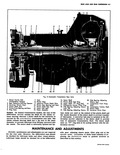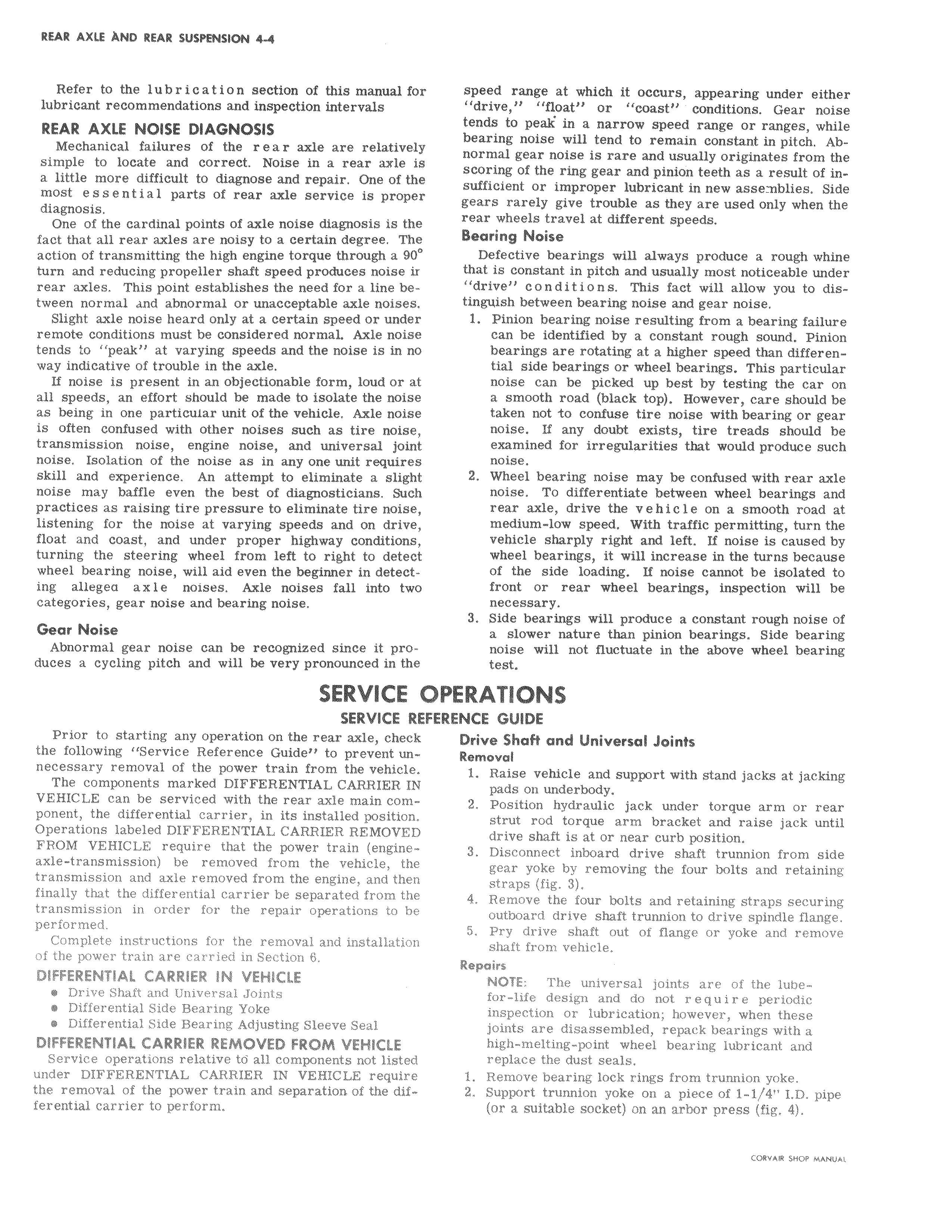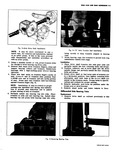Jeep Parts Wiki | Ford Parts Wiki
Home | Search | Browse | Marketplace | Messages | FAQ | Guest
|
Corvair Chassis Shop Manual December 1964 |
|
Prev

 Next
Next
Refer to the 1 u b r i c a t i o n section of this manual forl lubricant recommendations and inspection intervals REAR AXLE NOISE DIAGNOSIS Mechanical failures of the r e a r axle are relatively simple to locate and correct Noise in a rear axle is a little more difficult to diagnose and repair One of the most essential parts of rear axle service is proper diagnosis One of the cardinal points of axle noise diagnosis is thel fact that all rear axles are noisy to a certain degree The action of transmitting the high engine torque through a 90 turn and reducing propeller shaft speed produces noise ir i rear axles This point establishes the need for a line between normal and abnormal or unacceptable axle noises Slight axle noise heard only at a certain speed or under remote conditions must be considered normal Axle no sej tends to peak at varying speeds and the noise is in no l way indicative of trouble in the axle If noise is present in an objectionable form loud or a all speeds an effort should be made to isolate the noise as being in one particuiar unit of the vehicle Axle noise is often confused with other noises such as tire noise transmission noise engine noise and universal joint noise Isolation of the noise as in any one unit requires skill and experience An attempt to eliminate a slighi noise may baffle even the best of diagnosticians Sucl practices as raising tire pressure to eliminate tire noise listening for the noise at varying speeds and on drive float and coast and under proper highway conditions turning the steering wheel from left to right to detec wheel bearing noise will aid even the beginner in detecti ing allegea axle noises Axle noises fall into two categories gear noise and bearing noise Gear Noise Abnormal gear noise can be recognized since ft pro I duces a cycling pitch and will be very pronounced in the SERVICE IOP SERVICE REFERI Prior to starting any operation on the rear axle check the following Service Reference Guide to prevent un necessary removal of the power train from the vehicle The components marked DIFFERENTIAL CARRIER IN VEHICLE can be serviced with the rear axle main eomr ponent the differential carrier in its installed position Operations labeled DIFFERENTIAL CARRIER REMOVE FROM VEHICLE require that the power train engine axle transmission be removed from the vehicle th transmission and axle removed from the engine and thel finally that the differential carrier be separated from the transmission in order for the repair operations to be performed Complete instructions for the removal and installation of the power train are carried in Section 6 DIFFERENTIAL CARRIER IN VEHICLE Drive Shaft and Universal Joints Differential Side Bearing Yoke Differential Side Bearing Adjusting Sleeve Seal DIFFERENTIAL CARRIER REMOVED FROM VEHICLE j Service operations relative td all components not listed under DIFFERENTIAL CARRIER IN VEHICLE require the removal of the power train and separation of the differential carrier to perform I I speed range at which it occurs appearing under either drive float or coast conditions Gear noise tends to peak in a narrow speed range or ranges while bearing hoise will tend to remain constant in pitch Abnormal Oar noise is rare and usually originates from the scoring df the ring gear and pinion teeth as a result of insufficient or improper lubricant in new assemblies Side gears rarely give trouble as they are used only when the rear wheels travel at different speeds Bearing iNoise Defective bearings will always produce a rough whine that is nstant in pitch and usually most noticeable under drive conditions This fact will allow you to distingqish tween bearing noise and gear noise 1 Pinion bearing noise resulting from a bearing failure can be identified by a constant rough sound Pinion beartings are rotating at a higher speed than differential side bearings or wheel bearings This particular noise can be picked up best by testing the car on a smooth road black top However care should be taken not to confuse tire noise with bearing or gear noise If any doubt exists tire treads should be examined for irregularities that would produce such noisle 2 Whe l bearing noise may be confused with rear axle noise To differentiate between wheel bearings and rear axle drive the v e h i c 1 e on a smooth road at mectum low speed With traffic permitting turn the veWle sharply right and left If noise is caused by wheel bearings it will increase in the turns because of 1 he side loading If noise cannot be isolated to front or rear wheel bearings inspection will be necessary 3 Sid bearings will produce a constant rough noise of a slower nature than pinion bearings Side bearing noise will not fluctuate in the above wheel bearing test ERATIONS WE GUIDE Drive Shaft and Universal Joints Removal 1 Raise vehicle and support with stand jacks at jacking pads on underbody 2 Position hydraulic jack under torque arm or rear strut rod torque arm bracket and raise jack until driVe shaft is at or near curb position 3 Disconnect inboard drive shaft trunnion from side gear yoke by removing the four bolts and retaining straps fig 4 Remove the four bolts and retaining straps securing outboard drive shaft trunnion to drive spindle flange 5 Pry drive shaft out of flange or yoke and remove shaft from vehicle Repairs NOtE The universal joints are of the lubefor4life design and do not require periodic in ection or lubrication however when these jo s are disassembled repack bearings with a high melting point wheel bearing lubricant and replace the dust seals 1 Rerihove bearing lock rings from trunnion yoke 2 Sup rt trunnion yoke on a piece of 1 1 4 LD pipe or suitable socket on an arbor press fig 4 CORVAIR SHOP MANUAL

 Next
Next